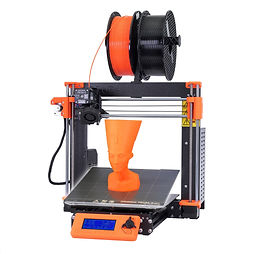3D Printing Guides, Tips and Reviews
How Does 3D Printing Work?
3D printing is an additive manufacturing process in which three-dimensional objects are created from digital files. This process was first invented in the mid-1980s in which a printer uses various materials such as plastic polymers, resin or even metal to create 3D objects.
Types of 3D Printing
Although there are many different printers available, only nine basic types of 3D printing technology currently exist, the most common of the three being Stereolithography (SLA), fused deposit modeling (FDM) and selective laser sintering (SLS). Printing with plastic filament uses the FDM process with a variety of materials.
Price of a 3D Printer
The technology of home 3D printing seems out of reach for a lot of people, it's not as expensive as you might think. With the variety of offerings there is bound to be a printer to fit your budget. Take a look at our guide to give you a good overview of what you can expect to get from printers of different price points.
Guide: 3D Printing Filament
Although there are many different printers available, only nine basic types of 3D printing technology currently exist, the most common of the three being Stereolithography (SLA), fused deposit modeling (FDM) and selective laser sintering (SLS). Printing with plastic filament uses the FDM process with a variety of materials.
3D Printing Nylon
3D Printing Nylon Nylon filament is an extremely tough, semi-flexible material that is highly impact- and abrasion- resistant. Its low friction coefficient and high melting temperature make it an ideal material for an array of engineering applications. Nylon is prevalent in fabrics and fibers but can be found in a myriad of other products.
3D Printing Flexible
3D Printing Flexible Filament Flexible filament, commonly referred to as a Thermoplastic Elastomer (TPE) or Thermoplastic Polyurethane (TPU) is known for its elasticity allowing for 3D prints that bend and stretch. Multiple degrees of flexibility from semi-flexible to ultra-flexible make for a wide array of applications.
Types of Flexible Filament
While there are several materials on the market that have flexible properties, the two major types of flexible filament are Thermoplastic Polyurethane (TPU) and Thermoplastic Elastomer (TPE). Both of these are made from thermoplastic elastomers which are derived from a blend of hard plastic and soft rubber.
3D Printing Polypropylene
3D Printing Polypropylene (PP) is a widely used thermoplastic material made from a semi-crystalline polymer. It is semi-rigid in nature and has excellent fatigue resistance, making it ideal for packaging and storage applications where a tough but semi-flexible material is needed.
3D Printing Polycarbonate
3D Printing Polycarbonate (PC) is a thermoplastic material known for its strength, durability and optical clarity (transparency). Known commercially as Lexan®, polycarbonate has many applications, including CDs, DVDs, bulletproof glasses, sunglass lenses, scuba masks, electronic displays and others.
Guide: Spool Comparison
3D printer spools come in many different styles and sizes. Most 3D printers will accept spools that fall within a set of industry accepted standards. Our spools are designed to fit most 3D printers that accept a standard spool size. Makeshaper offers three spool sizes: 1 kilogram, 2.25 kilograms, and 5 kilograms
3D Printing Supports
I need to add supports to my 3D print; what are they? While FDM printing has come a long way since its infancy, there is still room for improvement. The nature of 3D printing creates objects by building layers-upon-layers, relying on the underlying layers to support the next. Some objects with overhanging elements will need support.














